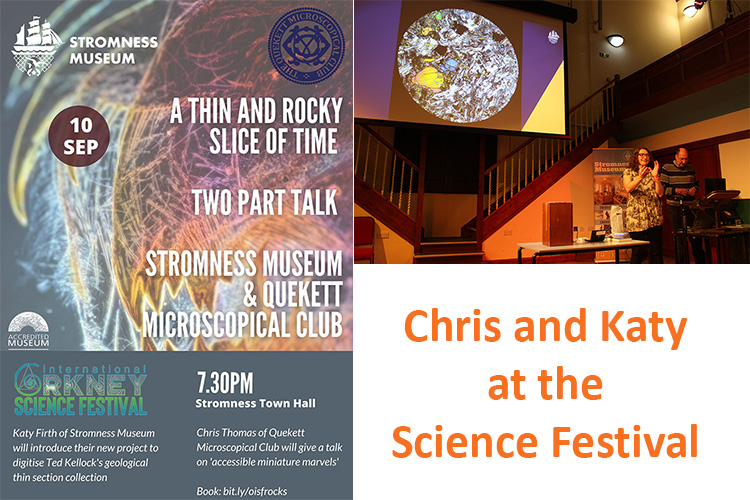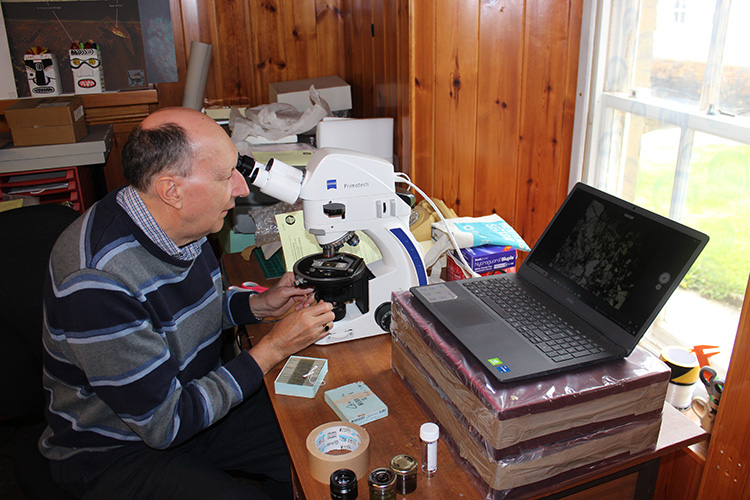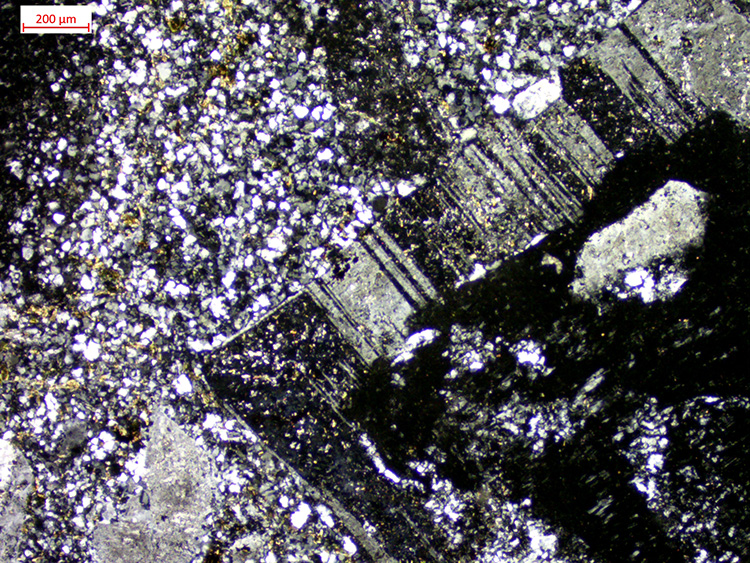Ted Kellock Collection Project
The Orkney Natural History Society Museum, Stromness
Introduction
The Ted Kellock Collection comprises about 4000 microscopical rock slides prepared by amateur geologist and naturalist Ted Kellock (1920-2009) which was gifted to the Orkney Natural History Society Museum (the Stromness Museum). The collection is curated by Katy Firth, who is engaged on a project to digitise the collection and produce a catalogue suitable for circulation on the internet. Digitisation is by polarising photomicrography and the Quekett is involved, through Dr Chris Thomas, in an advisory capacity. Chris has spent some of the summer on Orkney with Katy and he and Katy gave an illustrated talk to local primary school children.
The Stromness Museum is a small, independent institution primarily run by voluntary trustees. To support the project, the Quekett is providing funding for a Project Coordinator and Museum Curator to undertake the work, web developer fees to make the collection catalogue and selected rock slide images accessible online, repacking materials, promotion, and other operational expenses, with the goal of preserving, digitizing, and sharing a valuable geological collection, while also promoting community engagement and education in the field of geology.
The Quekett funding is crucial to making this project a reality and ensuring the long-term impact of this unique invaluable geological collection, held in the Stromness Museum. The collection will serve as a vital research tool for geologists interested not only in Orcadian rocks but also in broader Scottish geology and international geological studies, and the digitisation project will benefit both local and international audiences. Moreover, it carries a unique potential for community engagement, helping raise awareness about geological polarised light microscopy and promoting a wider understanding of rocks and the geological processes they record.
The project involves several key components, including the recruitment and training of local and remote volunteers to scan and transcribe information from microscope slides. These efforts are complemented by expert contributions from individuals like Peder Aspen and John Faithfull. The project also entails photography of the slides, utilising a Zeiss geological microscope and the expertise of microscopists, both local and regional. The resulting data will be integrated into the museum’s online catalogue, and there are plans for outreach activities, such as talks for Quekett members, public talks in Stromness, participation in science festivals, and engagement with schools. Additionally, through matched funding secured for this purpose, the project aims to develop a permanent exhibit within the museum showcasing rock samples and slides.
Summer 2023
The Project is now well under way. Chris Thomas and Katy Firth summarise the Summer’s progress:
Chris had an extremely busy time on Orkney between 7th and 12th September, not only catching up on the project and providing additional guidance to Katy on the optimal use of their Zeiss geological microscope, but also giving joint talks and microscopy-related activities at two schools as part of the Orkney Science Festival.

In addition to a low power inspection microscope and camera Chris included his 1957 Watson Kima with a new stage, which allowed him to demonstrate at talks and allow volunteers to come up and use it, showing that some modern additions, like LED lighting and an eyepiece camera plus some polarising film, could give excellent results with a basic microscope as long as it had good optics.
At the Science Festival talk, an astonished beekeeper queried Chris’ Orkney Honey sample – to find out that it was her honey pollen and crystals being used as examples!
An email by another audience member, from the local Field Club, landed in Katy’s email inbox with the message below:
I am also just wondering whether we can somehow link in Chris Thomas in any way to give general advice on how to get good results with simple equipment and how to use camera attachments etc (I was impressed that he was using a very old microscope and the polarising sheets were interesting too – I always thought you needed a whole new microscope for that). Even tips on making up slides (mine are always so messy, though that’s probably just me!).
So it looks as though Chris has really made a hit at Stromness. He also got to see Skara Brae and the Standing Stones of Brodgar and Stenness, as well as meeting up with Alan Jones, our local active contributor to the Quekett Bulletin.
Volunteer Recruitment
Peder Aspen – an existing volunteer – is a retired geology curator. Katy met Peder on 27th June for a live session with the microscope. Peder has been transcribing written information on slides into a spreadsheet using commonly- understood geological terminology (e.g. shorthand for quartz Qtz). Katy set up meeting with Chris Thomas and Peder Aspen.
Kyle Adam – a journalism graduate – has volunteered for two days scanning slides and has had a session using the microscope.
Barry Squire – a retired mineralogist, has isolated Orkney rock slides from spreadsheet and will prepare some interpretive text on them using his geological knowledge for use on website and in exhibition. Barry also spent half a day with the microscope.
Rebecca Braddock – has had an introductory session (including the microscope) and is a digital artist. She may do remote-transcribing.
Ruairidh McCallum has begun slide scanning and transcribing. A museum studies graduate, he has registered for Saltire Volunteering Awards to have his hours recognised.
Kim Batchelor – gemstone specialist who attended the talk on 10th September is going to soon begin transcribing data from slides remotely.
Digitisation Progress
We are scanning sets of about 20 slides at a time using a flatbed scanner at high (1200dpi) resolution. Volunteers have been assisting with this.
Of the set of six drawers of slides we are now digitising drawer 6. However there are in addition a number of boxes of slides which have been only partially digitised. The spreadsheet currently has 1135 slides transcribed. The spreadsheet will be formatted by Katy for upload to museum catalogue (e.g. given accession numbers). The last slide in the sequence is no 4301 – we are unsure as yet how many slides of this sequence are in the museum, as some of Kellock’s spreadsheets note that slides have been loaned to British Geological Survey or National Museum.
Polarising photomicrography
Katy has had a training session with MetPrep (Zeiss UK agent) to set up microscope camera software (Labscope) and she has begun to take some slide images.

Chris Thomas setting up the Zeiss Primotech microscope
Chris Thomas has provided support for post-processing of images and stacking. He also provided additional microscope set-up support.
 An image from the Primotech digitisation
An image from the Primotech digitisation
We will prioritise photographing a selection of Orcadian rocks to tell the story of Orkney’s geology. Barry will help with this and Katy will also consult Dr John Flett Brown, a local geologist.
Accessibility
Slides will be searchable on online catalogue and will be accessed via a dedicated page on the museum’s website. The page will give an overview of the collection and the services available to researchers – e.g. in-person viewing or virtual viewing with collections staff facilitation. Fragmented databases from Pete Kellock (Ted’s son) with differential information and paper archive – could be useful for researchers to access during site visits.
Original rock samples
We have begun this with the help of volunteer Ruaridh McCallum to make an inventory of the rock samples from which the thin-sections were made and to re-pack them from rusty biscuit tins and degrading plastic bags.

